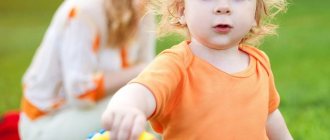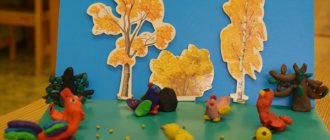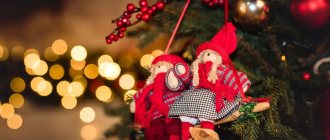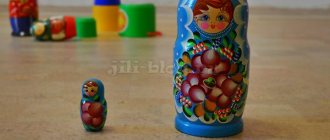MAGAZINE Preschooler.RF
Summary of direct educational activities on speech development for children of the early age group “Cockerel and his family.”Goal: To introduce children to poultry: cockerel, hen, chicks.
Tasks:
Educational:
- Introduce children to the concept of “family” .
- Learn to answer questions in words and sentences;
- to develop the ability for dialogical speech.
- Distinguish and name words with opposite meanings (big-small).
- Learn to recognize and name the characteristic external features of a bird (beak, wings, feathers, comb, beard);
- learn to correlate speech with movement when playing a nursery rhyme;
Activate your vocabulary using the words: hen, cockerel, chickens, chick, pecks, big, small. "beard" , "comb" .
Developmental:
- Develop speech hearing and speech activity in children, encourage onomatopoeia
- Develop communication skills. Stimulate speech development and the motor side of speech through the development of fine motor skills and tactile sensations.
- Develop children's mental processes: attention, memory, thinking.
Educational:
- Cultivate a caring attitude towards birds. Emotional responsiveness. The desire to care and help loved ones.
Integration of educational areas: speech development, social and communicative development, cognitive development, artistic and aesthetic development, physical development.
Preliminary work
- Conversations on the topic “Domestic animals and their young”
- Didactic games “Who eats what” , “Who gives what voice?”
- Looking at the painting “Rooster Family”
- Reading poems and asking riddles on the topic “Pets”
- Reading Russian folklore works that tell about a cockerel, a hen, and chickens.
- Listening to music: A. Filippenko “Chickens”
- Learning the M/P game “Chickens”
- Learning the nursery rhyme “Cockerel”
Facilities:
- organizational (tables, masks for playing, model of a poultry yard, millet, clothespins)
- methodological (visual aids (round base-sun, image of a cockerel, hen, chicks), pictures with the image “Poultry yard” )
- technical (recording of voices: cockerel, hens, chicks, poultry yard; laptop, DVD with images on the topic, etc.)
Main part.
I. Organizational moment:
Educator: Guys, look, a guest came to us today. She will watch how you can play and have fun; how beautiful and good you all are. Let's say hello to her and give her our smiles!
Articulation gymnastics “Smile” pulled the lips to the ears, smiled like frogs.
Educator: Guys! Today we have a fun, joyful day. Everyone is in a good mood, but for some reason our sun is sad.
Educator: Let's cheer up the sun. (motivation).
- We will give him some rays. (development of fine motor skills)
(Take yellow clothespins and attach them to the round base).
Educator: What color clothespins did you attach? Finally, the sun woke up and began to shine!
II. Main part.
Educator: Who gets up with the sun and sings songs loudly? He doesn’t let the kids sleep and sings... (an audio recording of “ku-ka-re-ku” ).
-Who is screaming so loudly? (Cockerel).
Educator: Let's call him: “Cockerel, cockerel! Come to us!" (the phrase is repeated).
Educator: What a beautiful cockerel!
(An image of a cockerel appears in front of the children. The children examine the cockerel.
The teacher offers to show where the cockerel's eyes, tail, beak, paws, head, and wings are.
The teacher draws attention to the characteristics of the cockerel:
- The rooster is large, he has a red comb and beard on his head, he has a lush, beautiful tail, bright feathers.
Breathing exercises “Feather” .
Teacher (blows on a feather and releases it, the children watch it fly, the teacher offers to play with the feathers)
- Do you want to blow on it too (children’s answers).
Educator: How does the cockerel sing?
Invite the children to remember the nursery rhyme about the cockerel!
Cockerel, golden comb cockerel. Oil head, Silk beard.
Why do you get up early? Do you sing songs loudly? Don't you let the kids sleep? Children: “Ku-ka-re-ku!”
(development of speech hearing, development of the motor side of speech and the ability to imitate the voices of poultry)
(audio recording of “chicken clucking” ).
Educator: And who is that there, guys, cackling? (Hen)
-Let's call the chicken. What are we going to call her? (chick - chick - chick)
Educator: Look, is the chicken the same as the cockerel?
(distinguish between sizes: size - “big – small” )
The cockerel is big, and the chicken... (I encourage you to finish the sentence)
The cockerel has a large tail, while the chicken has a small tail.
How does the chicken talk? (ko - ko - ko)
The cockerel is the daddy, and what about the hen? (Mother). They have baby chickens. And together they are a family.
Educator: Oh, let's tell you about your family.
Finger game: “My Family”
The game consists of saying a nursery rhyme:
This finger is grandpa, This finger is grandma, This finger is daddy, This finger is mommy,
This finger is me.
(development of fine motor skills of hands, speech, interest in folklore, attentiveness, ability to concentrate; nurturing good relationships between children, adults and children).
Educator: Guys, but the chicken came alone, without chickens, all her children were chickens, they went out for a walk with her and ran away in all directions, she did not have time to catch them, and now she is afraid that the chickens will not return to her.
- Do you want to help the chicken? Remember what chickens eat?
- That's right, chickens peck grains.
(The teacher, together with the students, examines the grains, says that the grains
round, yellow, hard and small because chickens have small beaks).
Educator: Let's pour grains for the chickens and they will return to their mother chicken.
(sprinkle grains - development of fine motor skills)
Educator: Guys, how does a hen call her babies? (Ko-ko-ko)
(an audio recording of “pi-pi-pi” ).
The chickens saw the grains and immediately ran.
-Look, what chickens? (we look at the chickens)
-How do chickens squeak?
-The chickens returned to the mother hen and the father cockerel and it turned out to be a friendly family.
-Do you want to turn into chickens yourself?
-Close your eyes tightly and the magic will begin!
(the teacher puts chicken hats on the children)
Game “Hen and Chicks” (audio recording “Chicks” )
The chicken went out for a walk, the teacher with the chicken in his hands and the children plucked fresh grass, walked in a circle, and behind her were the children, Yellow chickens!
Ko-ko-ko! Ko-ko-ko! stop and threaten Don't go far! row your index finger with your paws, squat down and use your fingers to look for grains! raking and looking for grains
They ate a fat beetle, they knocked an earthworm on the floor with their fingers, they drank some water, they brought up their palms with “water”, a full trough! to the mouth - drink “water”
Yellow chickens, Nice kids, They sleep under their mother’s wing, the children cuddle up to the teacher. It’s so cozy in that house!
Children repeat the movements after the teacher.
III. Final part. Bottom line.
-Who did you help today?
-Who do chickens like?
-When they are all together, what can they be called? (family)
-And who do my kids love?
IV. Surprise moment. Because you did not leave the chickens in trouble and helped them return to their family, the cockerel gives you wax crayons so that you learn to draw beautifully and draw “The Cockerel and his family.
| Next > |
↑ What is pestushka
Pestushki include playful interaction with a child, when an adult performs movements “for him”, playing with his arms and legs. The baby may still not be able to perform such movements as turning the body, he cannot purposefully use his hands, he cannot sit down, crawl, or stand on his own - all this will come to him during the 1st year of life. It is during this period that the mother nurtures the baby: plays with his hands, strokes the baby’s tummy, and makes “stomps” with his legs. The mother caresses the awakened baby, touching her with light massage movements, and gently says:
“Stretchers, Porostunyushki, Across the fat one, And in the legs - walkers, And in the arms - grabbers, And in the mouth - a talker, And in the head - a mind.”
Or:
“Stretch! Little ones! Across the fat girl, Hands are grasping. Legs are runners."
Massage, turning the head, throwing arms over the head, waving the hands with mother’s help, etc. - all this not only physically improves the baby’s health, but also gives him a lot of pleasure. If at the same time the mother cheerfully says:
“I knead, knead the dough, There is room in the oven, Bake, bake a loaf! Little head - go ahead, go ahead!”
—
what is happening causes an emotional “outburst” in the child, a need to contact an adult, and most importantly, a desire to repeat those movements that he cannot yet perform on his own. With each repeated play, the mother feels increasing activity in the baby’s movements. Listening to the mother’s affectionate recitative, the baby anticipates the play movements, laughs and already puts his head up, stretches out his arms, stretches out his legs, etc., waiting for a familiar turn in the game. So, with the help of pestles, the baby’s playful “training” begins.
Also entertaining for children is rocking on their feet, “jumping” and swaying on their mother’s or father’s lap, grandmothers imitating a horse race, riding down a mountain, dancing, etc. Of course, such games are useful for older children, when the baby can already sit well and rise to his feet on his own:
Let's go, let's go With nuts, with nuts! Let's gallop, gallop with rolls, with rolls! Leap, skip, over bumps, over bumps - into the hole - bang!
The adult throws the child on his knees, and then pretends to lower him down (pinches him with his knees and puts him back on the “horse” (“sleigh”, “cart”, etc.).
The road is good, The road is good, Something has become worse, Something has become worse, Playing around, playing around, Playing around, playing around, On the bridge, under the bridge, On the bridge, under the bridge, Thump in the hole!
Exercises that prepare a child for mastering walking are useful.
Toki-toki-toshki, I forge, I forge legs. Antoshka's legs are driving along the path, The path is crooked, There is no end, no edge.
While reciting the rhyming lines, the mother alternately spanks the baby's feet, which reflexively react to light touches, as he lies on his back. This is how an adult forms a sense of the rhythm of walking when stepping with one leg or the other.
When a child begins to master walking, other pestles come to the rescue, for example:
Ta-ta-ta, ta-ta-ta, A cat married a cat; The cat walks along the bench, leads the cat by the paws, stomps and stomps on the bench, tugs and tacks by the paws.
While pronouncing these verses, the mother holds the baby by the arms and, stepping back, carefully leads him along. The rhythm of the verse is set by the ri, the “tsap-tsap” coincides with the steps of the stepping child.
The baby can be led in another way: an adult holds him from behind by the armpits and, spreading his legs wide apart, encourages him to step with his legs.
Big feet Walked along the road: Top-top-top, Top-top-top. Little legs ran along the path: Top-top-top, top-top-top! Top-top-top, top-top-top!
Pestlers are also entertaining for the child, thanks to which he learns to make rhythmic clapping with his palms. The adult grabs the baby’s hands and, bringing them closer, says:
“Okay, okay, where have you been? - At Annushka's. What did you eat? - Pancakes. Where are the pancakes? “We ate... No pancakes!”
(The child’s arms are spread to the sides.)
Game continues. The adult suggests going to Panichka:
Okay, okay, where have you been? - At Panechka's. What did you eat? -Gingerbread! Where are the gingerbread cookies? Ate... No gingerbread!
(The child’s arms are spread to the sides.)
Then the adult offers to “go” to Mikeshka for some nuts, then to Troshka for some potatoes, and then to Senechka for some seeds (by analogy). The important thing is that while playing, the child learns to fold his hands when he hears the word “okay” and perform playful movements with his hands in the rhythm of the song.
Nursery rhymes about pets
The cat has a kitten, the duck has a duckling, the bear has a bear cub, the horse has a foal, the pig has a piglet, the sheep has a lamb, the cow has a calf, the hen has a chick, the dog has a puppy, and the mother has a son .
I will tie the goat to the white birch tree, Stop, my little goat, stop, don’t butt, White birch, stop, don’t sway.
I bought a ram bagel At the market early in the morning I bought a ram bagel: For the lambs, for the sheep TEN poppy rings, NINE dry cakes, EIGHT buns, SEVEN flatbreads, SIX cheesecakes, FIVE shortcakes, FOUR crumpets, THREE cakes, TWO gingerbreads AND ONE kalach I bought - Not to myself I forgot! And for the wife - sunflowers.
The piggy piggies are unhappy: “Oink-oink-oink!” they shout and scream, “We don’t want noses like that!” Only two holes stick out.
Goat-goat: -Me-me-me! I'm learning to count in my head! What is two plus five?... Me-me-me, I forgot again! Mom will be very upset! Me-me-me - I’m running to study.
The old man was walking along the road. The old man was walking along the road, along the road, along the road. He found a goat without horns, without horns, without horns. Come on, goat, let's jump, jump, jump, and jump with our legs, jump, jump. Come on, let's spin around, spin around, spin around. And we'll be friends forever, we'll be friends, we'll be friends. And the goat butts, butts, butts, And the old man swears, swears, swears.
Nursery rhymes about wild animals
The wind rustles the trees, our hedgehog is in a hurry to go home. And a wolf meets him, a click hits the hedgehog with his teeth. The hedgehog showed his needles, the Wolf ran away in fear.
Hedgehog, hedgehog, eccentric, I sewed a prickly jacket. He wants to play with us, count all the guys.
Who lives in the dark forest? Aren't you afraid of the bear and the fox? Who clicks with sharp teeth? Did you guess it? It's a wolf!
Shadow-shadow-shadow Shadow-shadow, shadow, Above the city there is a fence. The animals sat under the fence and boasted all day. The fox boasted: “I am beautiful to the whole world.” The bunny boasted: “Go and catch up!” The bear boasted: “I can sing songs!” The hedgehogs boasted: “Our fur coats are good!”
The old hare is mowing the hay The old hare is mowing the hay, And the fox is raking it up. The fly carries hay to the cart, and the mosquito throws it. They took me to the hayloft - a fly screamed from the cart: “I won’t go into the attic, I’ll fall from there, I’ll break my little leg, I’ll be lame.”
Snail Snail, snail, Stick out your horns, I'll give you, snail, a piece of pie! Crawl along the path, I'll give you some cakes.
Ladybug Ladybug, Fly to the sky, Bring us bread, Black and white, Just not burnt.
Nursery rhymes about a bunny for children
Little Bunny, come into the garden, Little Gray, come into the garden. Bunny, bunny, come into the garden, Gray, gray, come into the garden!
Little Bunny, pick the color, Gray, pick the color. Bunny, bunny, pick the color, Gray, gray, pick the color!
Zainka, make your wreath, Gray, make your wreath. Bunny, bunny, make your wreath, Gray, gray, make your wreath.
Little bunny, dance, Gray, dance. Bunny, bunny, dance, Gray, gray, dance.
You can sing this nursery rhyme and perform the movements together with the bunny. And most importantly, it’s easy to come up with a continuation of the nursery rhyme yourself and diversify the movements.
The gray bunny is sitting. The gray bunny is sitting and wiggles its ears. That's how, that's how He moves his ears!
It's cold for the bunny to sit, I need to warm my little paws. That's it, that's it. We need to warm our little paws!
It's cold for the bunny to stand, the bunny needs to jump. Like this, like this The bunny needs to jump!
The wolf scared the bunny! The bunny immediately ran away!
***
Oh, you, oblique hare Oh, you, oblique hare - like that! Don't follow me - like that! You'll end up in the garden - just like that! You'll gnaw off the whole cabbage - like this, When I catch you - like this, When I grab you by the ears - like this, And I'll twist your tail - like this!
Bunnies Bunnies run across the meadow, then the forest. The strawberries are being picked, hop and hop! Jump and jump! Here the clearing is softer than silk, Look around, look around! Beware of the dashing wolf, Beware, beware! The bunnies fell asleep sweetly, the forest is noisy! The forest is singing! - Run away without looking back: The wolf is coming, the wolf is coming!
In the garden there is noise-noise-noise, Bunny-bunny: crunch-crunch-crunch, Jump-jump-jump on the stumps, on the stumps, Ate a carrot - yum-yum-yum!



